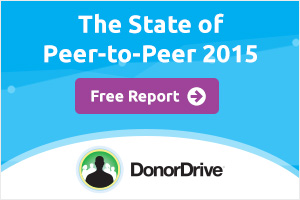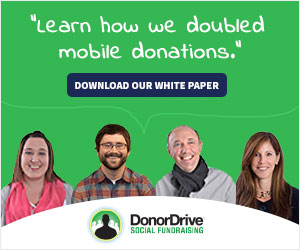Every fundraising professional knows how critical the last quarter of the year is. According to the Center on Philanthropy, the average person makes 24% of their annual charitable contributions between Thanksgiving and the end of the year. In fact, more than 30% of Network for Good’s donations are processed in the month of December. During this time of the year, people are more willing than usual to make a charitable contribution. It’s responsibility of the fundraising professional to make sure that those donations are made and that they are as large as possible.
In 2013, individuals in the U.S. gave over $241 billion to charities. A seemingly large number, except when compared to retail spending in the U.S. during the same year, over $3 trillion. In fact, Americans spent $59 billion in retail just in the weekend following Thanksgiving. Like charitable giving, retail spending rises during the end of the year. But even though more is being spent in both sectors, money is finite, and charities must compete with retail brands for the same dollars. If fundraising professionals want to win this competition, they’ll need capture the hearts, not just the wallets of Americans.
In many ways, the playing field between nonprofit and for-profit business is not level. For one thing, fundraisers will never be able to spend on marketing and advertising like their for-profit counter parts. For another, a charity only offers the intangible to the public. At first glance, it’s easy to concede that the odds are stacked against nonprofits, but believe it or not, there are plenty of tools that a nonprofit marketer has it their disposal that would make any chief marketing officer jealous.
Charities offer their contributors a sense of fulfillment and well-being. Any car manufacturer or fashion brand would like their customers to believe their products offer fulfillment, but in the long-term, giving contributes to happiness in a way that retail spending can not. If I had to choose between the two, offering a product or fulfillment, I’d rather be selling a feeling and in a position to deliver, than selling a pair of jeans and a lie. Consumerism is rampant in U.S., giving nonprofit organizations a perfect opportunity to remind their contributors that of all the products on the shelves and listings online, the closet thing they or anyone else can buy to happiness is a donation to charity. And when someone buys into that idea, the nonprofit needs to communicate to that supporter that they have done a good thing and should allow themselves to feel good as a result. This “thank you, you’re awesome” message must be authentic, and as such, should be time consuming. But a heartfelt, genuine thank you will pay off in a way that is as powerful as it is difficult to fully measure. Whatever you do, don’t create a heartless, form, or generic thank you, your supporters can smell in-authenticity a mile away.
The goodwill that charities can harness is a part of their unfair advantage, and it contributes to something else that every for-profit business is chasing, evangelism. A retailer has customers. A nonprofit has supporters. In the for-profit sector, a community manager has the goal of creating evangelists out of a customer base. An evangelist is a customer who will go out and spread the brand message and share a company’s products or services to the people they encounter. Since the advent of religion, word of mouth marketing is one of the most powerful strategies available to marketers. In the more recent past, word of mouth marketing has become more powerful than ever with the advent of social media.
Fortunately for nonprofit marketers and fundraisers, this evangelical behavior is baked into the culture of charitable giving. After making a donation, a nonprofit’s customer becomes a “supporter,” and is then responsible for spreading and promoting the cause. Any donation to charity is a gift that supports the fulfillment of a mission. Everyone that makes a donation is making an investment in that nonprofit’s success, and it’s in their best interest to see the mission succeed. Nonprofit fundraisers need not be afraid of asking supporters to spread the word. Take the opportunity to replace that donate button with a call to action to spread a message every once in awhile. Whether it be on social, through word of mouth, or by creating a personal fundraising campaign, supporters are willing to get involved if only asked directly.
While nonprofit professionals might have a few advantages over retailers vying for consumer dollars, the truth is that these groups have enormous resources that will never be available to nonprofits. Nonprofit professionals need to look at what these brands are doing and replicate it for their own industry. Taking what for-profit business has learned from hard-earned research, testing, development, and study, nonprofit fundraisers can replicate strategies for their own goals. Then, applying the nonprofit’s unfair advantages: inherent good-will of charity and the power of supporters, nonprofits might begin to capture a larger piece of the American spending pie.
Sources: 1. http://www.nptrust.org/philanthropic-resources/charitable-giving-statistics/ 2. http://www.charitynavigator.org/index.cfm?bay=content.view&cpid=519#.VEAlAPldWJ0 3. http://www.forbes.com/2006/07/19/spending-income-level_cx_lh_de_0719spending.html 4. http://brandongaille.com/20-consumer-discretionary-spending-statistics/ 5. http://www.gallup.com/poll/172532/consumers-spending-not-things.aspx 6. http://www.statista.com/statistics/243448/holiday-retail-industry-sales-in-the-united-states/
About the Author: Dylan Nord works with nonprofits to maximize fundraising through We-Care.com. Working with partners like the ASPCA, the National Autism Association, Save the Children, and Clean Water Action, Dylan has helped supporters raise over $4.6 million dollars through We-Care.com. Dylan believes that small deeds can add up, that we all have a responsibility to do good, and that technology is creating collaboration that will change the world. Dylan holds a Bachelor of Arts from Hartwick College in Oneonta, New York. Follow him on Twitter @dylannord





